
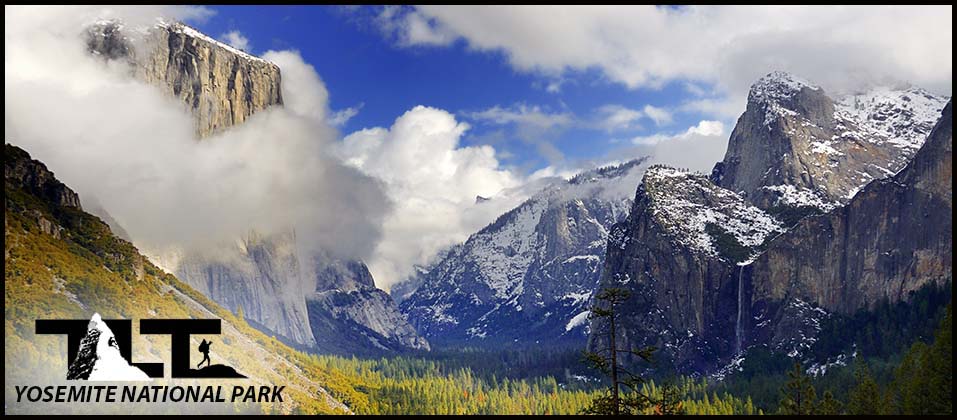 Yosemite National Park - is one of the most visited natural landscapes in the world. John Muir did not call Yosemite the "Crown Jewel" of the Sierra Nevada for nothing, for few places in the range have so much to offer the weary souls of this modern era.
Yosemite National Park - is one of the most visited natural landscapes in the world. John Muir did not call Yosemite the "Crown Jewel" of the Sierra Nevada for nothing, for few places in the range have so much to offer the weary souls of this modern era.I fell in love with Yosemite very early on in my outdoor experiences in the Sierra Nevada. My first introduction to the California Sierra was a hike up Mt Whitney with my brother and father, but latter on while exploring the huge eastern escapement of this great mountain range my wife and I wandered over Tioga Pass and entered into a magical landscape known as Tuolumne Meadows. This was our first introduction to Yosemite National Park and instinctively we knew that we had stumbled onto something very special.
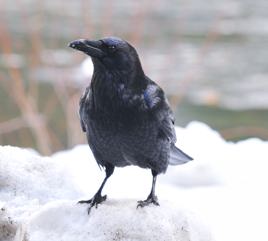 We came back again to this upper section of Yosemite and backpacked to the top of Yosemite Falls from the high country. From this vantage point we then peered down into Yosemite Valley for the first time. We were amazed at all the micro sized vehicles buzzing about far below and were delighted with the wonderful panoramas that surrounded us. That same day we hiked back to our vehicle and proceeded down hill to a point where we passed through a three quarter mile long tunnel that exited into a small parking lot just off the road. We then got out of our car and gazed into lower Yosemite Valley and were awe struck. No photo could ever do justice to what we witnessed. It became quickly obvious to us that we would be spending a lot of time exploring this jewel of the Sierra.
We came back again to this upper section of Yosemite and backpacked to the top of Yosemite Falls from the high country. From this vantage point we then peered down into Yosemite Valley for the first time. We were amazed at all the micro sized vehicles buzzing about far below and were delighted with the wonderful panoramas that surrounded us. That same day we hiked back to our vehicle and proceeded down hill to a point where we passed through a three quarter mile long tunnel that exited into a small parking lot just off the road. We then got out of our car and gazed into lower Yosemite Valley and were awe struck. No photo could ever do justice to what we witnessed. It became quickly obvious to us that we would be spending a lot of time exploring this jewel of the Sierra.Yosemite National Park is located in the central section of the Sierra Nevada Range in the state of California. It is approximately 3.5 hours by motor vehicle from San Francisco, and 6 hours from the city of Los Angeles. The 1200 square mile park is surrounded by the following wilderness areas. To the southwest is the Ansel Adams Wilderness, to the northeast, is Hoover Wilderness, and to the north is Emigrant Wilderness.
The 1,200-square-mile park contains multitudes of lakes and ponds, 1,600 miles of streams, 800 miles of hiking trails, and 350 miles of roads. Annual park visitation exceeds 4.5 million. But statistics are not why people keep coming back to Yosemite.
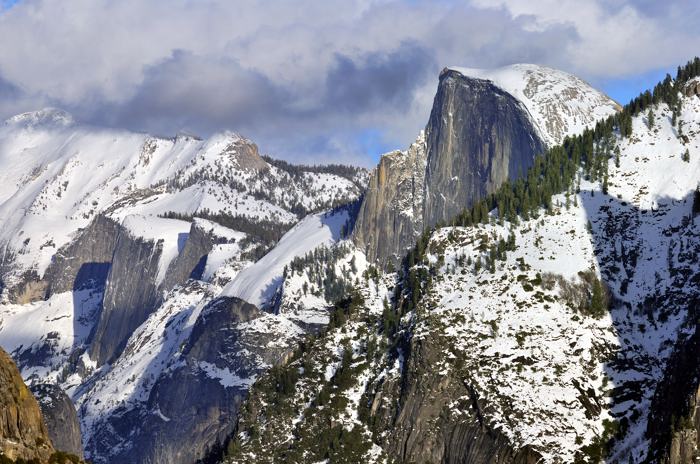 Towering granite walls graced with North Americas highest waterfalls are just a couple of the many reasons why people love Yosemite so much. Half Dome (photo to the left), is the traditional icon of Yosemite Valley. It soars nearly 4,800 vertical feet above the valley floor.
Towering granite walls graced with North Americas highest waterfalls are just a couple of the many reasons why people love Yosemite so much. Half Dome (photo to the left), is the traditional icon of Yosemite Valley. It soars nearly 4,800 vertical feet above the valley floor.In the month of October 1875, George Anderson reached the summit of Half Dome by drilling and placing iron eye bolts into the smooth granite to assist him in his success (he placed the eye bolts about every 5 feet or so, and then stood on his last bolt placement, while drilling in the next). Later, in 1919, his method was adopted by the Sierra Club who placed a pair of post-mounted steel braided cables near Anderson's original route. Today, this setup is known as the Half Dome Cable Ladder Route. The park service, during the month of May, will put the "Cable Ladder" up the last 975 feet of the 45 degree of polished rock. This allows access up the final pitch so that hikers (who are in good condition) can make the final climb all the way to the top of Half Domes 8,836 foot summit. The sheer northwest face of Half Dome is also a draw for technical climbers from around the world.
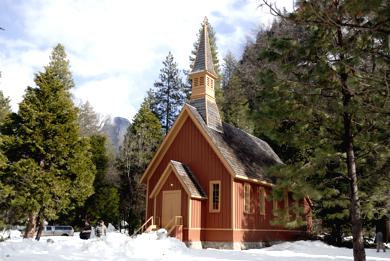
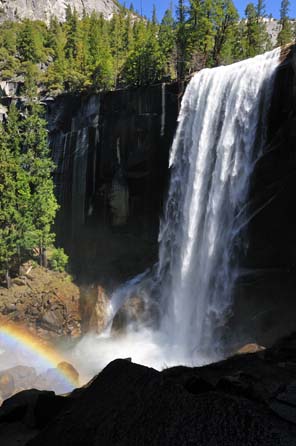 Half Dome is just one of the many attractions in Yosemite. Vernal Falls as seen in the image, gets it's name from the canyon below, because it is kept lush and green all year round from the watery spray from above (thus the name vernal which means springtime). In contrast to the horsetail plumes of most of the other falls in Yosemite, Vernal Falls is square and broad. At 320 feet it is not the highest waterfall in Yosemite, but it is certainly one of the most beautiful. For a spectacular hiking suggestion, check our our page on the Mist Trail. Note the beautiful rainbow in the lower left corner of the photo. This is a common site around Vernal Falls, due to the abundance of sunlight and mist that come together in this special part of the world. I find that from mid April through June are the best times to experience Yosemite's waterfalls. But each year is different, depending on the snowfall (or the lack of it). So check with the park service before making your plans to visit the park.
Half Dome is just one of the many attractions in Yosemite. Vernal Falls as seen in the image, gets it's name from the canyon below, because it is kept lush and green all year round from the watery spray from above (thus the name vernal which means springtime). In contrast to the horsetail plumes of most of the other falls in Yosemite, Vernal Falls is square and broad. At 320 feet it is not the highest waterfall in Yosemite, but it is certainly one of the most beautiful. For a spectacular hiking suggestion, check our our page on the Mist Trail. Note the beautiful rainbow in the lower left corner of the photo. This is a common site around Vernal Falls, due to the abundance of sunlight and mist that come together in this special part of the world. I find that from mid April through June are the best times to experience Yosemite's waterfalls. But each year is different, depending on the snowfall (or the lack of it). So check with the park service before making your plans to visit the park.Above to the left, we have a photo of Yosemite Chapel. In the spring of 1878, the California State Commissioners of the Yosemite Grant received an application “from the Rev. J.K. McLean and others, representing an association known as the Sunday School Union, for permission to erect in the Yosemite Valley a chapel, which should be used for nondenominational purposes.” The application was granted, and the beautiful structure was erected the following year near where the present Four Mile trailhead is located today.
The chapel, which is the oldest structure in Yosemite Valley, was designed by Charles Geddes, an accomplished church architect from San Francisco. Geddes’ son-in-law, Samuel Thomson—with whom he collaborated on other church projects—is believed to have been the project's contractor. Designed in a "New England style" to seat 250 people, the chapel originally consisted of only one room, 26-by-50 feet long, with inside stud walls and rafters left exposed. Countless people over the years have taken time out of their busy vacation schedules to attend services in Yosemite National Park's little Chapel.
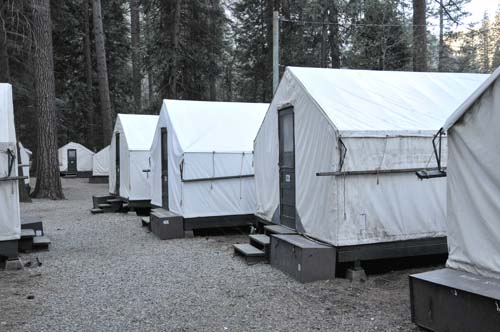 Most of Yosemite's visitors hang around the valley floor which consists of a piece of landscape that comprises only one mile in width and seven miles in length. During the months of July and August it can be as jambed with traffic (both vehicle and pedestrian) as many metropolitan centers during rush hour.
Most of Yosemite's visitors hang around the valley floor which consists of a piece of landscape that comprises only one mile in width and seven miles in length. During the months of July and August it can be as jambed with traffic (both vehicle and pedestrian) as many metropolitan centers during rush hour.But being in the heart of Yosemite Valley, is a very special experience even though the valley makes up only one percent of the parks 1,200 square miles. There are so many things to do in the valley, that it is well worth the time to explore. I have been in the valley a multitude of times over the years, and I always discover something new each time.
Even a nights stay in Curry Village's tent cabins (shown in the image above) can have an experience all it's own. Curry Village along with Yosemite Village are the two most active areas in the Valley. They contain most of Yosemite National Parks lodging, dining, stores, and other amenities. For those who want to skip the crowds, and sleep out under the stars, there are plenty of places in the wilderness to spread out your sleeping gear. But all back country overnight camping requires a wilderness permit. When my wife and I first backpacked Yosemite over 35 years ago, regulations were far and few between. But due to the multitudes of people who visit the park and the Sierra Nevada in general, have to be regulated in order to preserve the beauty of the wilderness for future generations.
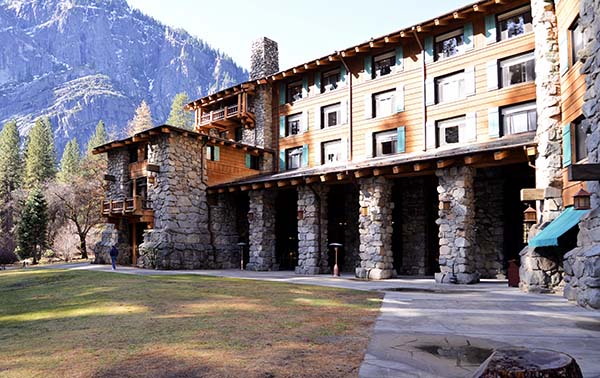 In the early 1900´s the first director of the National Park Service,
Stephen Mather, decided that Yosemite needed a first class hotel. Well the result of that vision was the Ahwahnee Hotel
(photo to the right)
(photo above)
and it is certainly a first class hotel. It was designed by architect Gilbert Stanley Underwood who was well known for the impressive hotels he had designed for Zion and Bryce Canyon National Parks. If you ever decide to stay in this beautiful structure, make sure you have reservations well in advance. I hear that Christmas time is very special at the hotel, but getting a reservation
for Christmas season has to be booked possible years in advance. But the Ahwahnee is just one of many places to stay. For more information, check out the following link: Where to stay in Yosemite.
In the early 1900´s the first director of the National Park Service,
Stephen Mather, decided that Yosemite needed a first class hotel. Well the result of that vision was the Ahwahnee Hotel
(photo to the right)
(photo above)
and it is certainly a first class hotel. It was designed by architect Gilbert Stanley Underwood who was well known for the impressive hotels he had designed for Zion and Bryce Canyon National Parks. If you ever decide to stay in this beautiful structure, make sure you have reservations well in advance. I hear that Christmas time is very special at the hotel, but getting a reservation
for Christmas season has to be booked possible years in advance. But the Ahwahnee is just one of many places to stay. For more information, check out the following link: Where to stay in Yosemite.Getting around in Yosemite can be a problem during the heavy traffic months from June through early September. But it is possible to get around the valley in the free shuttle system that runs daily from 7am to 10pm. The shuttle stops at most all the lodging areas, popular viewing sights, and popular landmarks. During the above time period, the shuttle comes around about every 15 minutes. During off-season, expect a 30 minute wait of so. But if you have the time, the best way to get around is on foot. Walking is the best way to slow life down, and that is why most people come to the park in the first place.
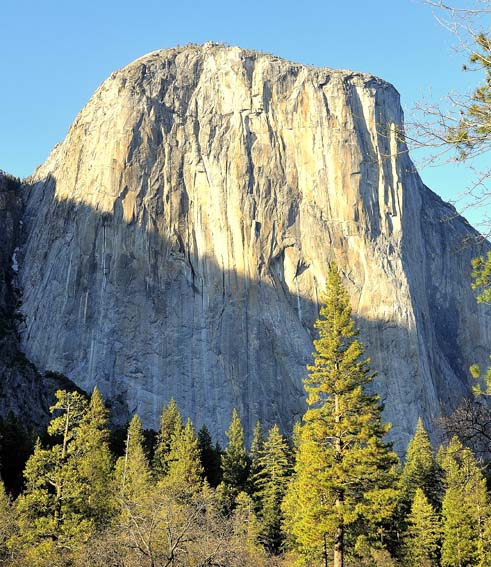 El Capitan as seen in the photo
to the left,
above,
is a massive granite block that
rises 3,604 feet above the floor of Yosemite. (elevation above sea level is 7,569 feet)
El Capitan as seen in the photo
to the left,
above,
is a massive granite block that
rises 3,604 feet above the floor of Yosemite. (elevation above sea level is 7,569 feet) The grand rock structure is highly resistant to erosion and contains very few joints or fractures. Features that makes it one of the most popular rock climbing locations in the world. The multi-day ascent of El Capitan requires climbers to use a number of advanced rock climbing techniques.
The first climber to scale El Capitan's sheer wall was Warren Harding, who put up the first route up the Nose of El Capitan in 1958. Using fixed ropes, and a mountain of bolts, Warren Harding and a couple of his friends reached the top in 45 days. I remember my parents taking interest in the climb, due to it being televised on the news when I was only 7 years old. Later Royal Robbins assembled a team and made the climb in 7 days. In 1975, Jim Bridwell made the first single day assent.
But with all due respect, having bolts in place saves lots of time for climbers who have followed in Warren Harding's footsteps. Nevertheless, the speed record that stands out above all the others, is Hans Florine and Yuji Hirayama's. They did the classic "Nose Route" in just two hours and forty eight minutes. A phenomenal feat to say the least. Check out the following link, to see a video of a speed climber going up El Capitan.
In recent times, Tommy Caldwell and Kevin Jorgeson reached the summit of 3,000-foot El Capitan on Wednesday January 14, 2015, marking the first free climb up the incredibly difficult Dawn Wall (which was widely considered too steep and too difficult for free climbing up until this ascent).They began their climb on December 27, 2014 and committed to living up on the side of El Cap for as long as it took each of them to free climb every pitch in succession. The ascent represented another breakthrough in the climbing history on El Capitan.
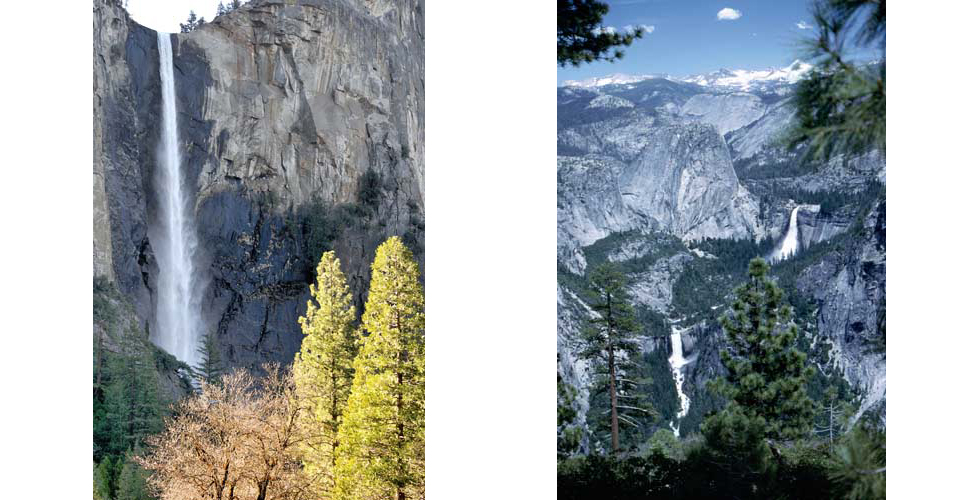
Then, in the right hand image above, you can see Nevada Fall (upper fall), and Vernal Fall (lower fall) as seen from the Panorama Trail between Glacier Point and Happy Isles. This is a great trail, and if you have someone to drop you off at Glacier Point, it is almost all downhill back to the valley floor. I remember doing it years ago as a backpack going from the Valley Floor all the way up to Glacier Point, and then completing the loop going down past Nevada and Vernal Falls and ending in Happy Isles. Later on, we did it as a day hike, The total loop involves 16 miles of hiking, and needless to say, I slept well that night.
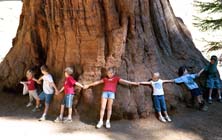 Yosemite is not only home to some of the worlds greatest waterfalls, and unbroken granite monoliths, it is also home of the Giant Sequoia. This monster of a tree, can weigh over two million pounds, and grow to a height of over 320 feet. It makes it the largest living thing on this earth.
Yosemite is not only home to some of the worlds greatest waterfalls, and unbroken granite monoliths, it is also home of the Giant Sequoia. This monster of a tree, can weigh over two million pounds, and grow to a height of over 320 feet. It makes it the largest living thing on this earth.The Sequoia can also reach an age of 3,200 years old, due to it being nearly immune to almost all known pests and diseases. The trees bark is also very thick, and resists fire to a very high degree. The Mariposa Grove in Yosemite is well worth visiting.
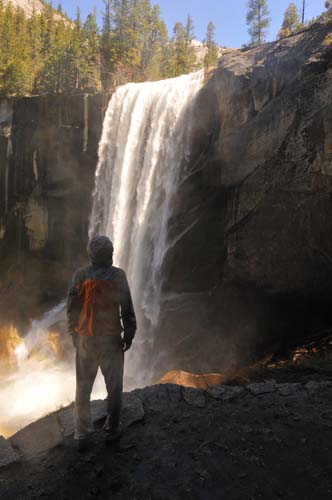 Vernal Fall is a beautiful waterfall
(image to the left)
(image above)
loacted along the Merced River just downstream from Nevada Fall.
It is 317 feet high, and is accessible via the Mist Trail. Vernal Fall is one of the many attractions for hikers that travel along the extremely popular Mist Trail. It is also clearly visible from Glacier Point.
Vernal Fall is a beautiful waterfall
(image to the left)
(image above)
loacted along the Merced River just downstream from Nevada Fall.
It is 317 feet high, and is accessible via the Mist Trail. Vernal Fall is one of the many attractions for hikers that travel along the extremely popular Mist Trail. It is also clearly visible from Glacier Point.The original name of the fall was Yan-o-pah ("little cloud") The fall was named "Vernal" by Lafayette Bunnell, a member of the Mariposa Brigade in 1851. Very likely Lafayette named the fall Vernal (for springtime) because the canyon below is kept lush and green all year round from the watery spray from above. In contrast to the horsetail plumes of most of the other falls in Yosemite, Vernal Falls is square and broad.
Hikers that choose to do the Mist Trail will start out at Happy Isles, which is located on the valley floor. The hike is one of the shortest (1.3 Miles one way) and it is the most popular trail in Yosemite National Park. As a participant on this trail, you will be treated to spectacular Vernal and Nevada falls (2.7 miles one way if you go to the top of Nevada Falls), roaring streams of snow fed water, Emerald Pool, marvelous trail engineering, and glacier carved granite cliffs (of awe inspiring grandeur).
The "Mist Trail" gets its name from the wind blown mist that tends to soak hikers as they pass by the falls. I have to say that while hiking up the trail in April of 2009, not only did I get a good drenching, but my digital SLR camera also got a good soaking. Thankfully Nikon did a good job weather sealing the D300 camera that I was carrying at the time. It made it through with no permanent damage (even though a got a bit concerned in some of the wettest areas). All this being said, its not a bad idea to bring some lightweight rain gear along for the outing.
The final 15 to 30 minutes of the trail involves a very steep climb up well placed granite steps in order to get to the top of the waterfall so the hike requires one to be in somewhat decent condition to complete the task, but all in all, Vernal Falls is one of Yosemite's most beautiful sights, and thousands of hikers each year take the time out to hike to the top of the Vernal Falls to relax in one of the parks most spectacular areas.
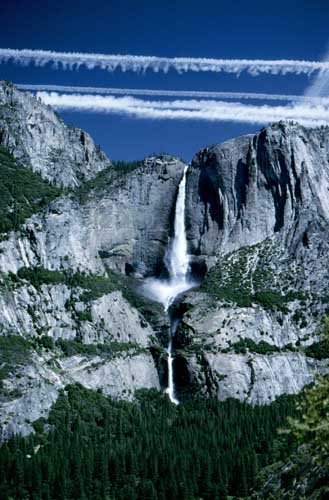
Yosemite Falls is actually made up of three separate falls: Upper Yosemite Fall (1,430 ft), the middle cascades (675 ft), and Lower Yosemite Fall (320 ft). You can walk to Lower Yosemite Fall in just a few minutes. A hike to the top of Upper Yosemite Fall is a strenuous, all-day hike.
Yosemite Falls is fed by Yosemite Creek, which drains 50 square miles of snow melt from the high country. Peak flow usually happens in late May, and 2,400 gallons per second flow over the lip of the upper fall. But by August, Yosemite Falls is often dry. It begins flowing again a few months later, after winter snows arrive.
Upper Yosemite Falls Trail (along with the Mist Trail) is also one of the classic hikes in Yosemite, and is certainly one of the oldest trails in the park. John Conway began building the trail in 1873, and completed the section to the top of Yosemite Falls in 1877. The state tried to buy the trail in 1882 but Conway refused to sell. The state did not give up, and the battle for the ownership of the trail went in and out of the courts over a period of years. Conway finally decided to sell it in 1885 for a sum of $1,500.00 (in todays money the sale would be just a bit over $24,000.00). This is still an incredible bargain if you take into consideration all the hard work that must have gone into the building of this trail, from the lower meadows of Yosemite Valley to the top of Yosemite Falls.
Well, that is just a small sample of Yosemite National Park's beauty. For more on Yosemite and all it has to offer, please do not hesitate to make use of the below links, for further information and possible adventures that you can experience in this most wonderfully preserved national treasure.
Deeper Insight - There is no doubt that Yosemite is one of the most beautiful National Parks in the United States, and possible in the world for that matter. Most of the four and a half million visitors each year would certainly testify to that fact. But as awe inspiring as Yosemite's landscape is, the Bible tells us in 1st Corinthians 2:9 that "No eye has seen, no ear has heard, no mind has conceived what God has prepared for those who love him"
In other words, God is preparing a place for those who love Him that far exceeds the most beautiful places here on earth.
In the Yosemite Valley visitor center, there is a plaque hanging in one of the display rooms that has a writing by environmentalist David Brower who wrote the following in 1991: "There are not many places left where we, ourselves, can choose whether to exploit or leave wild. Although the budget of natural things may have looked unlimited to, grandfather, we know it is a finite budget. Wilderness is a fragile thing. People can break it but they cannot make it. And we are quite capable, in our own time, of breaking it all – quite capable of using up all the choices America will ever have between saving and spending what is left of it’s unmarred natural heritage."
As I pondered this writing, I could not help but agree with the truth that man is incapable of creating anything. He can only destroy the beauty that God has created. The Gospel of John 1:1-3 explains this fact: In the beginning was the Word, and the Word was with God, and the Word was God. He was with God in the beginning. Through Him all things were made; and without Him nothing was made that has been made.
But as our world continues to wind down, we can take great hope that one day, God will renew all things.2 Peter 3:13 But we are looking forward to God's promise of new heavens and a new earth afterwards, where there will be only goodness.
For more on this most important subject please visit the following links:
"The Ultimate Journey" and the "Meaning of Life"
Email Sign Up
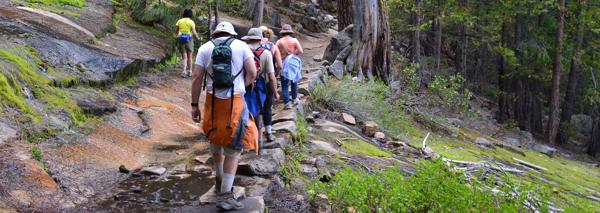
|
Join the Adventure! Sign up here for Timberline Trails Monthly Newsletter |

Join us on Instagram

©2006-2024 TimberlineTrails. All Rights Reserved.
....